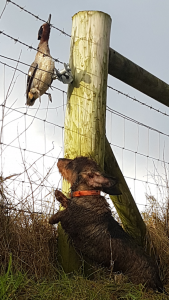Sausage Dogs and Little Boys Guns
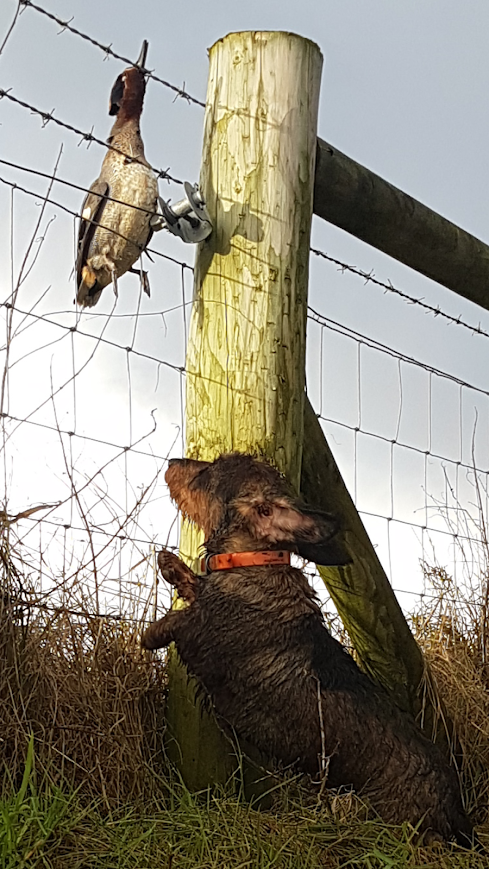
Frosty mornings seem to be less frequent these days than they used to be. Perhaps it is through rose tinted glasses that I look back and seem to recall so many Saturday mornings over a winter when a ferreter could hardly get a spade into the ground to recover a determined ferret. I feel over the last decade there has been a definite shift in the weather with wetter summers and warmer winters and those mornings when the ground was like bell iron are few and far between. Luckily over the winter of 2017 – 2018 we had a few of those nostalgic mornings and I took full advantage and slipped out for a spot of shooting. Not being the conventional type I didn’t load up a spaniel or pointer and nor did I put a 12 or even 20 bore into my gun slip. A Teckel and a 410 are my shooting partners these days, and it has made for some exciting and interesting sport as I would find out one frosty morning back in December. Oscar, a little Teckel born and bred in County Cork from a bitch called Pepper and sired by a Teckel called Dandy, Oscar is just about two years old and he and I are great friends and have been since I collected him back in September 2016 and in that short space of time we have had a lot of adventures. Oscar slotted in well from the beginning, while not a boisterous or overly confident puppy he was far from shy and showed his intelligence and keenness from a very early age. His first catch at only 16 weeks old was a moth and he proudly carried it around the garden for over an hour and continually dropped it picked it up again every time the lurchers got too close. A sensible pup, he took everything in his stride and was firm friends with the ferrets within a few days, stock breaking was a breeze however, edging on the side of caution I attached a long line to him in a field full of sheep and lambs one spring morning where the farmer lets me train the dogs and he paid no interest in them at all and never has since. I like any dog I own to do a little more than they are supposed to. Why should a Lurcher just go lamping or ferreting? I have taken all my Lurchers beating and shooting, but my bitch Fudge always had a knack for it since a pup and Paddy Boyd and the other lads always like to see her coming on the shoot days. She doesn’t really hunt the cover but will retrieve pheasants and ducks along with anything else except Magpies, they have a certain smell that puts her off. Shooting with her started quite by accident as one year the requirement in the syndicate was having a dog, I assumed a traditional Gun Dog but nobody specified exactly which type so I took her with me and have since. When someone folded a pheasant 15 minutes into the morning and she out run the Spaniels, cleared a small fence and retrieved it back to me I slipped into my bag, patted her head and acted like it was a normal thing, but of course I was beaming inside!
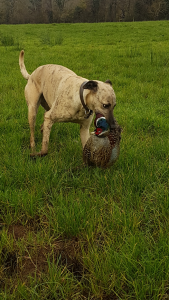
Of course, easily spotted pheasants and Ducks landing in open fields is all very well, but when it comes to the thick cover and necessity to actually go out and find something you didn’t see falling or in fact something falling in the black dark on a wet night it takes a different dog. A Labrador, Spaniel or something similar would be ideal – Except I had a Teckel. This too happened by accident. I was exercising Oscar one evening along the river and had the gun when ducks began to drop in as the light fell. I was sure there would be a few more and rather than walk him back to the van and then return to shoot I made my way to the ditch, got banked in and set him on my knee. Within less than a minute two mallard crossed and we folded one. After another few minutes he had another and sat another perhaps 15 minutes and saw nothing else. I knew the second bird landed on the flat field out in front but the first was somewhere behind me. I walked off in the dark for a look and Oscar ran ahead. With a head lamp I squinted round roughly where I though it had landed but to no avail. After a few minutes there was no sign of my young German aside from a bit of snuffling and snorting in a hedge close by. I climbed under, shone the torch and found him attempting to drag a large Mallard Drake from some blackthorn! This was to be the beginning of a new shooting partnership! The next I shot a Rook overhead, and again it fell well into some Ferns that had died back. I could see the bird but didn’t show him and he rummaged and searched about until he found it but just like his kennel mate Fudge, made no attempt to lift it.
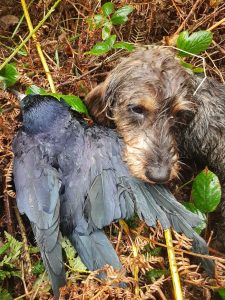
Over the last few years I have taken to shooting with a .410 and find it excellent for everything I do. I shoot inland ducks & Snipe more than anything else and walking many miles and sometimes over rough ground the little gun is a pleasure to carry. People often speak of the “range” of a .410 and suggest that it is simply not enough for shooting “properly” and it is a children’s gun which in my opinion is quite incorrect and the gun is very misunderstood which is unfortunate. Used correctly and within its limits as opposed to worrying about its range and you will find the .410 more than effective for all but the highest pheasants. Often seen as a novelty gun or something for messing about, the .410 was allegedly the gun of the Poacher. The old drilled out Rook rifle or the folding version being among the favourites. My own is an Italian model, it folds and can slip inside a jacket pocket for easy transport. I have shot pheasants, ducks, Snipe, Pigeons and many rabbits with my .410 and the more I do the more I like it.
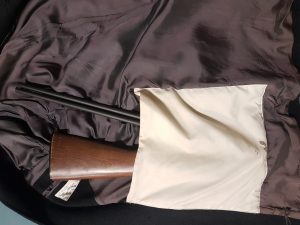
This year I shot almost exclusively with it, and one frosty morning back in December I loaded it into my van with trusty Teckel and we made for the drainage ditches of home for a shot, or as it turned out quite a few! Not lacking in intelligence as sometimes suggested about Dachshunds, Oscar has gotten the hang of the various shooting scenarios. He knows at night to sit on my knee or at myside until we go searching, and while walking the drains he will walk at heel reasonably well. Drain shooting and more so with a .410 becomes a sort of skill one has to acquire in order for it to work correctly. The water levels have to come into consideration, too high and the birds will see you approaching easier you must keep far enough back while walking not to startle them too far ahead for a shot, while at the same time not keeping so far back as you miss them, this part of it makes it all the more exciting! I have developed my own method of walking the drains in semi circles a hundred yards or so apart and that leaves room for error in front or behind. This particular morning Oscar and I set off in the rain and had folded three birds on the first stretch, followed by a brace and a further brace on the next stretch, we were going very well indeed. Any birds that landed in the water (so long as they had some movement) he is happy to retrieve and any that landed on the field he will approach and stay with but not retrieve. It works well for me as the drains in flood are deep and wide and often difficult to retrieve fallen birds from anyway. Young Oscar has developed some strange habits as he has grown, amongst these are howling and whining very quietly for about ten minutes after he gets in his kennel after being fed. He sleeps in a very large wine cask with a small Teckel size hole in the front and it is an ideal kennel for him, very warm, very dry and quite “European” but also with quite an echo when he “settles” for the night. Following the wind down whine as I call it, he pushes some bedding over the hole and that’s him until I arrive in the morning or someone disturbs him. His next is fences. Terriers or dogs too small to jump usually go through the bottom of the wire, that would be too normal! He climbs up three squares of mesh, wiggles through and falls down the other side! On the day in question he crossed every fence the same and every time he heard a splash, he squeezed through the drainage wire to find the bird. Over two days we shot over a dozen Teal realistically it was a little too much but we used them all, and after I removed the breasts the dogs got the rest, Oscar being a particular fan of the feet, waste not want not I suppose! A day or two after our Duck adventure we had an invitation to some rabbit ground, too thick to ferret so I decided the Childrens Gun and the Sausage dog would be ideal and what a day we had! The scent was quite obviously heavy, as Oscar hit the ground running as soon as we arrived and within seconds of him opening up a shot rang out on the far side followed by another. What again is quite strange is that should he follow a rabbit or anything from the cover at full speed and it is shot, he immediately stops, turns round and goes straight back in! He worked tirelessly all day and although I left most of the shooting to my host and enjoyed watching the Teckel work, I managed a few rabbits again with the little gun.
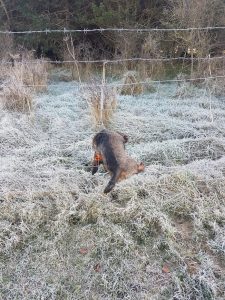
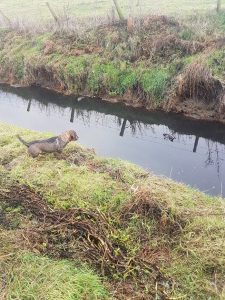
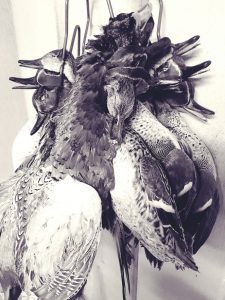
My own .410 is chambered to accept the variations in ammunition from 1.5”, 2”, 2.5” and 3” Magnum. I have found that nothing other than the 3” Magnums to be of use for Game Shooting and use correctly they are very effective although the high pressure of the 3” can cause disruptions in pattern in some cases. It appears now with offerings from the major Gun manufacturers that the popularity of the .410 is on the rise and this cannot be a bad thing as it perhaps may reduce the cost of ammunition which can be a fraction more expensive than other larger manufactured calibres. There is available on the market some suppressed versions of .410 shotguns, and for my work as a rabbit controller these would be ideal is if wasn’t for the huge length of them! I have found quite a suitable alternative in the form of Lyalvale Magnasonic cartridges, designed to be used in these suppressed firearms but which in my opinion work very effectively in standard .410 and cut the report to a mere crack, not essential for everyone but useful for some.
